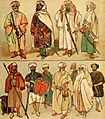Al-Andalus facts for kids
Al-Andalus (Arabic: الأندلس) was the name given by Muslims to the parts of the Iberian Peninsula (modern-day Spain and Portugal) they ruled. This period lasted for many centuries, from 711 to 1492. It was a time when different Muslim rulers, often called Moors, controlled these lands.
Al-Andalus was first a part of the large Umayyad Caliphate. Later, it became its own powerful state called the Caliphate of Córdoba (from 929 to 1031). After that, it split into smaller kingdoms known as taifas. For much of its history, especially under the Caliphate of Córdoba, Al-Andalus was famous for its learning and knowledge. The city of Córdoba became one of the most important cultural and economic centers in the Mediterranean and the Islamic world.
This civilization was very advanced in architecture and urban planning. The Moors became very rich by controlling the gold trade from the Ghana Empire in West Africa. They built many beautiful buildings across the lands they ruled. Many of these grand structures can still be seen today in cities like Seville, Granada, and Cordoba in Andalusia.
Contents
A Diverse Society in Al-Andalus
Muslim Spain was a very multicultural place. People from different backgrounds lived together. Jews, Christians, and Muslims often lived side by side. They usually showed a lot of tolerance for each other's beliefs.
There were also people called saqaliba living near the Mediterranean coast. These were descendants of European slaves. Even though they were first brought in as slaves, some of them became important generals. Like the Mamluks in other caliphates, some of these generals even became rulers of their own small cities (taifas) for a short time.
The End of Muslim Rule
Starting in 1236, Christian kingdoms began to take back the land. This period is known as the Reconquista. The Christian forces, led by Ferdinand III of Castile, slowly pushed south. The last Muslim stronghold was Granada.
Granada became a vassal state, meaning it had to pay tribute to the Christian kingdom of Castile. This lasted for 256 years. Finally, on January 2, 1492, Boabdil, the last Muslim ruler of Granada, surrendered. He gave complete control of Granada to Ferdinand and Isabella, the Catholic Monarchs of Spain. This marked the end of Al-Andalus.
See Also
- Umayyad Caliphate
- Islamic Golden Age
- History of Islam
- History of Spain
- Berber people
- Andalusia
- Moors
Films
Images for kids
-
Interior of the Mosque–Cathedral of Córdoba, once the Great Mosque of Córdoba.
-
Statue of Abd al Rahman in Almuñécar. He founded the Umayyad dynasty in Al-Andalus.
-
Map showing the size of the Almoravid empire in Al-Andalus.
-
The Giralda tower in Seville, built by the Almohads, a great example of Andalusi architecture.
-
A silk cloth from the Nasrid dynasty, the last Muslim rulers of Al-Andalus.
-
A painting showing Muhammad XII's family leaving the Alhambra after the Granada War.
-
The Court of the Lions inside the Alhambra, the palace of the Nasrid dynasty in Granada.
-
Male clothing from Al-Andalus in the 15th century, during the Emirate of Granada.
-
A Jewish cantor reading the Passover story in Al-Andalus, from a 14th-century book.
-
A section of the large hall in the Mosque–Cathedral of Córdoba, started in 785.
-
The Pyxis of al-Mughira, a carved ivory box made in 968.
-
Averroes, a famous philosopher from Al-Andalus.
-
A Jewish Street Sign in Toledo, Spain.
See also
 In Spanish: Al-Ándalus para niños
In Spanish: Al-Ándalus para niños



















